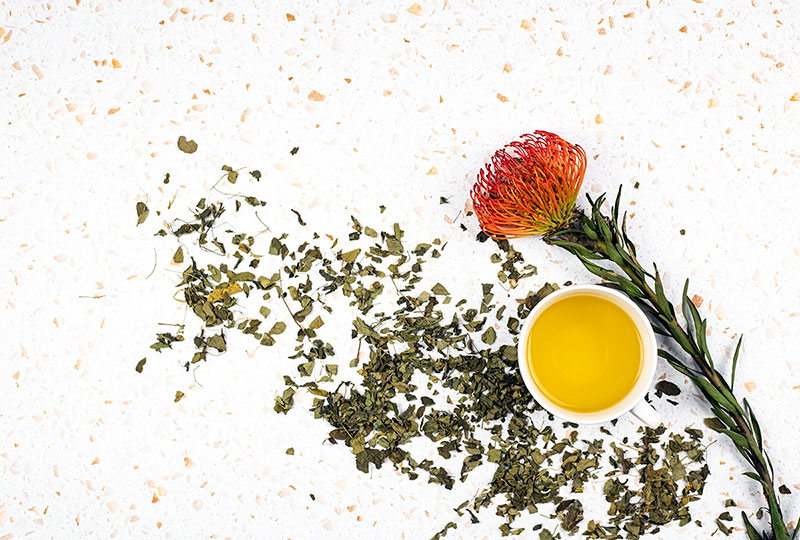Moringa Tea Guide
The world of herbal teas is as exquisite as the world of real teas. It offers thousands of scents, flavors, and benefits. While some teas, like chamomile, ginger and peppermint may already be a staple in many households, others are still rare and unknown, but nonetheless amazing. Moringa is one of them.
What is moringa tea?
Moringa tea is a herbal tea made from dried leaves of Moringa oleifera plant. Other names for moringa tree are horseradish tree, drumstick tree or benzolive tree. This tree is native to India where it’s used as food and herbal medicine. Today, moringa is also grown in other countries with tropical and subtropical climates[1]. Moringa tea is not a new tea, but it’s still mostly unknown outside of India. Only recently have western countries started to appreciate the benefits this tea might provide.
Different parts of the tree can be used–flowers, seeds, pods and leaves. Both leaves and seeds are high in proteins, vitamins and minerals and have a high nutritional value. Plus, it’s rich in flavonoids, such as myrecytin, quercetin and kaempferol,[2] it contains 27 vitamins including Vitamin A and Vitamin B6[3], minerals and other compounds. Sounds amazing? That’s why another name for moringa is – the Miracle Tree.
For making tea, flowers, leaves and seeds can all be used, but moringa tree leaf tea is the most common. All parts are caffeine free and you can drink a cup of moringa tea even in the evening.
Moringa Tea Benefits
This amazing tree has been a subject of many human and animal studies. Potential health benefits of moringa include:
1. Antioxidant properties
With its 46 different antioxidants[4], moringa leaves may help boost immune system, provide free radical scavenging activity and reduce oxidative stress. Studies suggest that is has a high antioxidant potential and may help fight free radicals that cause damage to the body’s cells[5].
2. High nutritional value
Moringa leaves can be used as food. They have a high nutritional value and may help treat malnutrition in many countries around the world. This tree is often called a “Miracle Tree”, as it is one of “the most nutrient-dense plants in the world.[6]” Furthermore, leaves can be harvested many times in a year, even more than a real tea plant, which makes it an important potential source of nutrients.
3. Antimicrobial properties
Studies have shown that moringa leaf extract may provide significant antibacterial activity against different Gram positive and Gram-negative bacteria, including Escherichia coli [7]and Staphylococcus epidermidis[8]. It may provide an antifungal and antiviral activity too[9].
4. Liver and kidney protection
Moringa may be helpful in reducing the kidney and liver damages caused by different drugs[10]. This activity mostly comes from moringa leaves and flowers.
5. Anti inflammatory properties
Moringa may be very beneficial for prevention of many chronic diseases, such as diabetes and other inflammatory diseases[11]. Inflammation is a body’s response to different injuries, viruses and bacteria[12] and may lead to many diseases.
6. Anti-diabetic properties
Research suggests that moringa may be a great choice for people with diabetes. Moringa leaves may help increase insulin activity, reduce blood sugar levels, provide anti inflammatory activity and improve glucose uptake[13]. It may help to lower blood pressure too[14] and help protect from heart diseases[15].
7. Anticancer properties
Moringa has anticancer properties and may help prevent some cancers. So far the anticancer effect of moringa has been studies on leukemia, liver cancer, pancreatic cancer, breast cancer, colon cancer and others[16].
How to make moringa tea
To make moringa tea you will need dried moringa tea leaves and freshly boiled spring water. Use about 1 teaspoon of loose leaf tea per cup of water. Steep in water for about 5 minutes, strain and drink. You can add sweetener if needed.
Want to make an energy boosting moringa blend? Try blending it with some green tea leaves.
What does moringa tea taste like?
Dry moringa leaves have a very strong scent with earthy and dry grass notes and light underlying sweetness. If you like the scent of autumn fields, cut dried grass and hay, you will like the scent of moringa leaves too. They have an olive green color. Moringa is available as loose leaf and powder. Brewed tea has an intense yellow color and a delicate scent similar to the scent of the dry leaves.
Moringa tea has a very pleasant flavor, with light hay notes and no bitterness at all. It leaves a very light sweet aftertaste. If you are not a fan of herbal teas because of their intense or bitter flavors, moringa may be the right herbal tea for you.
Best time to drink?
Because it’s a herbal tea, moringa contains no caffeine. You can drink it at any time of the day or night. Studies suggest that the daily dose for nutritional purposes may be 70 grams[17]. This means that even a few cups of moringa tea a day are likely to be safe. However, more study is needed to confirm potential side effects. Keep in mind that any herbal tea may interact with medication and other herbs.
Disclaimer: This article is for informational purposes only. It’s not intended to replace medical advice, diagnosis or treatment. Every person is different and may react to different herbs and teas differently. Never use teas or herbs to treat serious medical conditions on your own. Always seek professional medical advice before choosing home remedies.
References:
[1] https://www.sciencedirect.com/science/article/pii/S1995764516307143
[2] https://www.ncbi.nlm.nih.gov/pmc/articles/PMC5745501/
[3] https://internationaltreefoundation.org/moringa-miracle-tree/
[4] https://internationaltreefoundation.org/moringa-miracle-tree/
[5] https://www.ncbi.nlm.nih.gov/pmc/articles/PMC5745501/
[6] https://internationaltreefoundation.org/moringa-miracle-tree/
[7] https://www.ncbi.nlm.nih.gov/pmc/articles/PMC3331240/
[8] https://medcraveonline.com/JAPLR/phytochemical-and-antibacterial-activity-of-moringa-oleifera-available-in-the-market-of-mekelle.html
[9] https://medcraveonline.com/JAPLR/phytochemical-and-antibacterial-activity-of-moringa-oleifera-available-in-the-market-of-mekelle.html
[10] https://www.sciencedirect.com/science/article/pii/S1995764516307143
[11] https://www.ncbi.nlm.nih.gov/pmc/articles/PMC5745501/
[12] https://www.ncbi.nlm.nih.gov/books/NBK279298/
[13] https://www.ncbi.nlm.nih.gov/pmc/articles/PMC5745501/
[14] https://www.nutraingredients-latam.com/Article/2020/02/17/Debunking-a-myth-RCT-shows-Moringa-leaves-may-lower-blood-pressure
[15] https://pubmed.ncbi.nlm.nih.gov/26864583/
[16] https://www.ncbi.nlm.nih.gov/pmc/articles/PMC5745501/
[17] https://www.sciencedirect.com/science/article/pii/S2213453016300362





